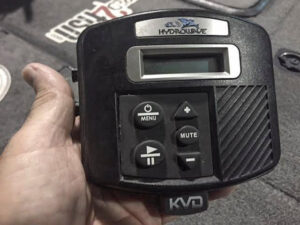Duck and goose hunters use a variety of calls to call specific types of waterfowl. Turkey hunters too have a variety of calls including diaphramn, friction, slate and box calls. It only makes sense that fish can be attracted by sounds as well.
Lure manufacturers have long incorporated sound into the development of lures with rattles, clicks and surface lures with repetitive motions. I can remember seeing gamefish run towards levee pumps when they started up and owners of lakes and farm ponds that feed their fish will tell you that the noise of the feeder conditions fish to move towards them.
Even walking the bank can add vibration that fish relate to either favorably or adversely. I have friends that feed their fish and just walking down to the bank gets them running towards their dock. So I believe the Hydrowave Sound Expansion Modules can work in your favor.
The first attempt at sound technology for fishing was Biosonix. It was a good idea that might have been ahead of its time. The Hydrowave gained notable acceptance with pro anglers and weekend anglers alike as a result of constant tweaking at Hydrowave/TH-Marine offices.
Initially it was the Hydrowave Incept but now they have introduced the H2, the mini, and additional sound modules that work in all of them. They continue to evolve and bring new sounds in the shad and baitfish line-up and have even introduced crawfish sounds into the mix as well. And now they are creating sounds more attractive to other species like walleye and crappie.
The Hydrowave Expansion Modules install easily in the bottom of the Hydrowave and come with longer screws for that installation. Additional sounds will appear on the display when powered up.
My Experiences
I believe in the technology of the Hydrowave (see how to install here), and now with the add-on modules of Bait Fish, Bream, Crawfish, Herring and the KVD performance modules, I will continue to utilize it as a tool for better fishing.
Using the Hydrowave Sound Modules is more of an application and not just a simple turn it on piece of gear. The more you use it, the more you realize the subtleties of the sounds are most important. I have found that louder and more is not necessarily better, and it’s the delays, turning it off and on, and utilizing it in conjunction with the conditions that prove crucial. Watching the weather, the baitfish and the wind are elements that help determine what sound and how loud it should be run.
I look to use the Bait Fish Modules heavily from the shad spawn through the summer to fall when baitfish congregate and move to the backs of creeks and pockets. The six new sounds include shad blitz, shad spawn, bait ball, shad eruption, spawn frenzy and suspended bait. I can see application for all of them.
One of the secrets to success with the Hydrowave is knowing when to turn it on and when to leave it turned off. I have completely quit using it in practice because just like the feeders or a rattling bait the fish can be behavior modified to those sounds. Small lakes where lots of anglers utilize it can be even worse. A good rule of thumb is low volume, subtle sounds on calm days and louder with more aggressive patterns on windy or rainy days. Dialing it in does take time on the water and some anglers do get disenchanted with it because it’s not a magic pill. There are no magic lures and also no magic sounds that help put more fish in the boat. It is truly matching the sounds to the type of baitfish or forage with pauses in those sounds that work best.
Just like a grunt call or the rattling of antlers to deer or the cluck of a friction call to a turkey the Hydrowave emulates natural sounds found in a natural environment and I believe it has positively impacted my catch rates. Walleye anglers, ice fishermen, and panfish anglers will also be intrigued by what it will do for them. Many ice anglers and walleye pros incorporate sound technology into their fishing.
The new modules are found at Tackle Warehouse and retail from between $59.99 to $79.99 depending on the module.














